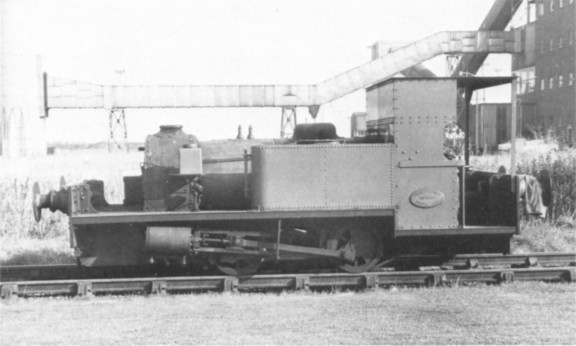
| THE INDUSTRIAL RAILWAY RECORD |
© APRIL 1974 |
PECKETT & SONS LTD
A BRIEF MEMOIR
M.J. LEE
In 1880 Peckett & Sons took over the business established by Fox, Walker & Company in 1864 at the Atlas Engine Works, St. George, Bristol. The last general manager, Mr Gibbins, who joined the firm from the Sudan Railways in the mid-1950's, surprisingly enough was a great nephew of the Fox of Fox, Walker & Company. Members of the Peckett family who were actively concerned with the firm were Thomas, Frank, Wilfred and Roy, the latter two gentlemen remaining until the business was taken over by Reed Crane & Hoist Co Ltd on 23rd October 1961.
The Deep Pit of the East Bristol Collieries Ltd was quite near to the Atlas Engine Works and, until it closed down about 1934, supplied an engine to shunt Peckett's Works. Thereafter Peckett's took over their part of the private branch railway running to Kingswood Junction on the LMSR Bristol to Birmingham line, and acquired Deep Pit's locomotive to work it. This was NANCY, an 0-6-0 saddle tank rather fittingly built by Peckett, works number 1067 of 1905. Owing to the somewhat restricted confines of two of the overbridges on the branch, the larger locomotives, when despatched by rail, had to be partly dismantled. In October 1927, Peckett 1745 for the Coventry Colliery of the Warwickshire Coal Co Ltd was despatched complete but came to grief when her cab roof struck the first bridge! She had to be returned to the Works for attention. From 1955 the branch did not really see a great deal of use, becoming expensive to maintain, and it came as no surprise, therefore, when it was closed in June 1958. A month later NANCY, not in the best of condition, was cut up outside the paintshop. Most of the track had been lifted by 1960, except for a short section at the Works which was retained for test purposes.

Peckett 1900 of 1936 photographed at Courtauld's Grimsby Works in 1962. The cab roof was raised there on its transfer from Greenfield Works, thus giving the driver slightly more normal conditions. (H.D. Bowtell)
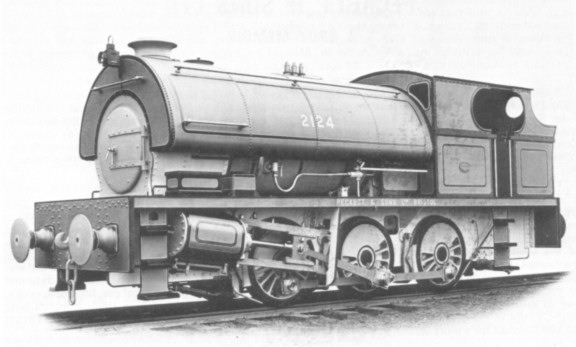
The official photograph of the OQ class. One of this massive trio still exists at Mardy Colliery, South Wales. (IRS Collection)
Probably the strangest engine Peckett's ever built was works number 1900 of 1936, a little "Dwarf" class standard gauge 0‑4‑0 side tank with 8in by 12in cylinders, 2ft 0in diameter wheels, and weighing 11 tons in working order. Specially designed to be able to negotiate a very low overbridge with a headroom of only 6ft 0in at the Greenfield Works, Flintshire, of Courtaulds Ltd, she had an overall height of only 5ft 9in. One had the consolation that, if falling from this locomotive, it wasn't far to drop!
The largest locomotive ever constructed by Peckett's was No.1824 of 1931, a standard gauge 0‑8‑0 with a six‑wheel tender, for the Christmas Island Phosphate Company. It had 18in by 26in cylinders, 4ft 6in wheels, and the engine alone weighed about 60 tons in working order. Christmas Island lies in the Indian Ocean over 200 miles off the southern shores of Java, and prior to the island's occupation by the Japanese in the Second World War, the locomotive was deliberately rendered inoperative by explosive charges placed in the cylinders. Apparently Peckett's sent out a set of replacement cylinders after the war, so the locomotive must have been rather well constructed! The largest engines for the home market were three 55 ton "OQ" class 0‑6‑0 saddle tanks with 18in by 26in cylinders and 4ft 0½in wheels built for the Tower and Mardy Collieries in South Wales in 1951 and 1954.
Peckett's smallest locomotive, No.1805 of 1929, was a diminutive 3ft 0in gauge 0‑4‑0 wing and side tank built for the Vauxhall Works in London of the South Metropolitan Gas Company. It had 5½in by 8in cylinders, 1ft 8in wheels, weighed about 6 tons, and was known by Peckett rather appropriately as the "Ant" class! During the Second World War Peckett's built locomotives only to their own designs, and received an order in 1941 from the Ministry of Supply for six "Yorktown" class engines. These were extremely small 0‑4‑0 saddle tanks with tiny 7in by 12in cylinders, 2ft 0in wheels, and weighing about 11 tons.
Frank Peckett did not favour building diesel locomotives, even when most of the other firms were turning their attention to this market in the 1930's, and the "steam only" tradition was maintained until 1954. However, in March of that year, after Frank had retired, the firm publicly announced in the Bristol evening newspaper that they were to enter the diesel shunter market because of the trends then prevailing in the locomotive trade. Wilfred Peckett had also been reluctant to build diesels, but by 1954 orders for steam engines were beginning to thin out and the change was one of economic necessity.
New drawing and general offices were opened at the works at about this time to assist the new project. Another change, to cut costs, was the introduction of welding, which removed a lot of character from locomotives built from 1955 onwards. One had grown accustomed to the neatly riveted cabs and tanks, for so long the hallmark of Peckett locomotives.
The first diesel emerged from the works early in 1956 and, after trials, went on hire to Albright & Wilson Ltd of Portishead. It was a 200hp 0‑4‑0 with a Crossley engine and a Hobbs gearbox giving direct mechanical drive. The design did not prove to be a success, probably because it arrived too late on the market when other makers' designs were established. The few diesels built are listed below with details of their subsequent histories. All were for standard gauge.
| 5000 of 1956. |
A 200hp 0‑4‑0 built for stock. Hired to Albright & Wilson Ltd of Portishead, Somerset, in 1956. Returned to Peckett in 1957 and sold to British Soda Co Ltd, Sandbach, Cheshire, on 27th January 1958. |
| 5001 of 1956. | A 200hp 0‑4‑0 built for stock and used for demonstration purposes. Dismantled about 1958‑59 and parts subsequently scrapped. |
| 5002 of 1957. | A 100hp 0‑4‑0 built for Albright & Wilson Ltd, Portishead, and delivered on 3rd July 1957. Passed to an unknown party for scrap, about 1971. |
| 5003 of 1958. | A 200hp 0‑4‑0 built for stock. Sold on 10th April 1961 to James Austin & Sons Ltd, Thornhill, Yorkshire. Presented on permanent loan to the Keighley & Worth Valley Railway in October 1971. |
| 5014 of 1959. | A 200hp 0‑6‑0 delivered on 31st August 1959 to the Aberthaw Power Station, Glamorgan, of the Central Electricity Generating Board. |
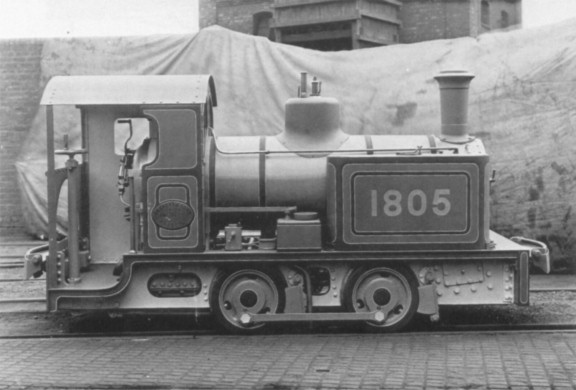
Many unusual features show well on this works photograph of Peckett 1805 of 1929 - the bushed ends to the side rods, the small Manzell lubricator, the cylinders positioned between the valve chests and the apparent lack of springing. The cab layout is also interesting for as the reversing lever must be on the left side of the engine, where is the fuel bunker? Perhaps coke always being at hand one was not considered necessary. Compare this illustration with that showing the other side of the loco on page 56 of RECORD 3. (IRS Collection)
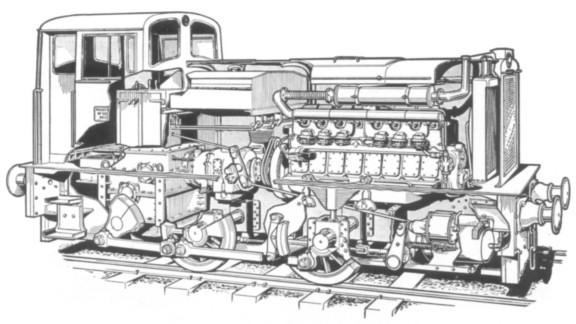
An unusual depiction of an industrial locomotive - a cut away view of Peckett's 200 hp diesel included in their 1957 desk diary. (IRS Collection)
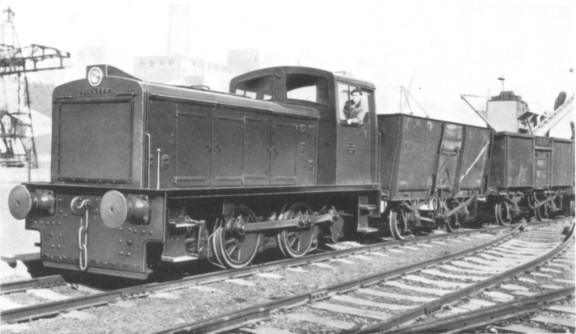
The first Peckett diesel - 5000 of 1956 - working at Albright & Wilson Ltd, Portishead, Somerset, in 1956. (IRS Collection)
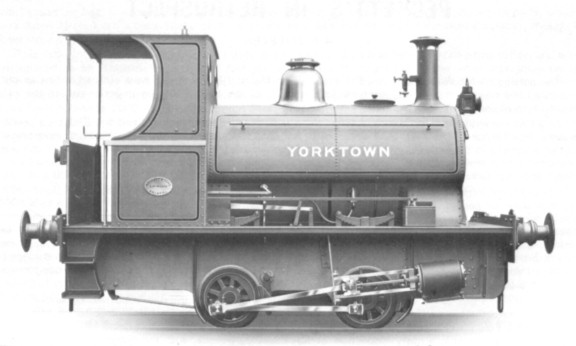
The official photograph of the Yorktown class, the initial example of which appeared in 1909. (IRS Collection)
The last steam locomotive to be built, No.2165, an outside cylinder 0‑6‑0 side tank for the 3ft 0in gauge system of the Sena Sugar Estates Ltd in Mozambique, left the Works on 12th June 1958. The very last locomotive to leave the Works, however, was diesel 5002. It had come in November 1961 for a change of gearbox ("Hobbs" to "Wilson"), and was returned to Albright & Wilson on or about 6th February 1962.
After the takeover, Peckett & Sons Ltd remained in business to supply spares (made by the Reed Crane & Hoist Co Ltd at Brighouse in Yorkshire). However, their excellent locomotives, which have been so much a part of the industrial scene, will emerge no more from the Atlas Engine Works.
'STRATFORD AND MORETON TRAMWAY. The G.W.R. are taking up the metals of the old tramway from Stratford‑on-Avon to Langston Road, on the Shipston‑on-Stour branch, in consequence of the Government requirements for materials that can be used in the production of munitions of war. The permanent way comprises the original rails and chairs laid down about 1826, as part of William James' scheme for a railway and canal from the Midlands to London. The tramway was always used for horse traction. As William James was a native of Henley‑in-Arden, the Lord of the Manor ... offered a site on the Guild House premises there, and now we hear that the G.W.R. are presenting the town with two lengths of rail, chairs and stone sleepers, to be preserved as a memento of the old tramroad.' ("The Locomotive Magazine'; 15th February 1918. A photograph of one of the tramway wagons presented by the GWR to the town of Stratford‑on-Avon for preservation was reproduced on page 276 of RECORD 11. - TJL)